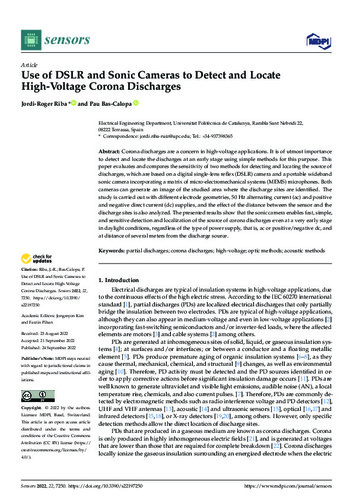Use of DSLR and sonic cameras to detect and locate high-voltage corona discharges

Visualitza/Obre
Cita com:
hdl:2117/374514
Tipus de documentArticle
Data publicació2022-09-24
EditorMultidisciplinary Digital Publishing Institute (MDPI)
Condicions d'accésAccés obert
Llevat que s'hi indiqui el contrari, els
continguts d'aquesta obra estan subjectes a la llicència de Creative Commons
:
Reconeixement 4.0 Internacional
Abstract
Corona discharges are a concern in high-voltage applications. It is of utmost importance to detect and locate the discharges at an early stage using simple methods for this purpose. This paper evaluates and compares the sensitivity of two methods for detecting and locating the source of discharges, which are based on a digital single-lens reflex (DSLR) camera and a portable wideband sonic camera incorporating a matrix of micro-electromechanical systems (MEMS) microphones. Both cameras can generate an image of the studied area where the discharge sites are identified. The study is carried out with different electrode geometries, 50 Hz alternating current (ac) and positive and negative direct current (dc) supplies, and the effect of the distance between the sensor and the discharge sites is also analyzed. The presented results show that the sonic camera enables fast, simple, and sensitive detection and localization of the source of corona discharges even at a very early stage in daylight conditions, regardless of the type of power supply, that is, ac or positive/negative dc, and at distance of several meters from the discharge source.
CitacióRiba, J.; Bas, P. Use of DSLR and sonic cameras to detect and locate high-voltage corona discharges. "Sensors (Switzerland)", 24 Setembre 2022, vol. 22, núm. 19, article 7250, p. 1-14.
ISSN1424-8220
Versió de l'editorhttps://www.mdpi.com/1424-8220/22/19/7250
| Fitxers | Descripció | Mida | Format | Visualitza |
|---|---|---|---|---|
| 145-SonicCamera-sensors.pdf | 3,836Mb | Visualitza/Obre |


